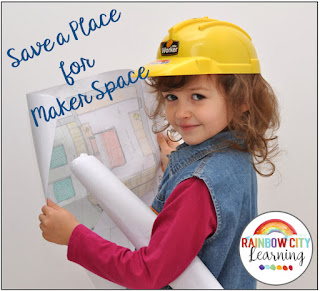Hi teachers! I’m Retta, from Rainbow City Learning, and I’m so happy to be a guest here on Hojo’s Teaching Adventures! I’ve been tinkering around with the idea of having Maker Spaces in elementary classrooms for several years, and I’m super excited to talk about saving a place in your room for a Maker Space today. This post is organized around some questions you may have about Maker Spaces, STEM, and STEAM.
What is a Maker Space?
Simply put, a Maker Space is an area where people can go to make things. This has been going on for some time, at least as long as we humans have had opposable thumbs. We’re really good at picking up things, and we love to touch and handle things. We are natural-born tinkerers. A Maker Space should have some materials to explore and some ideas for getting projects started. It can easily be set up in a small corner of your classroom.
Can I afford to have a Maker Space in my classroom?
A Maker Space can be very easily stocked with recyclables and donations. No fancy equipment like woodworking tools or 3D printers is necessary. For free lists and donation letters to stock your classroom Maker Space, click here. All you really need is a corner of your classroom, a table, and five empty boxes!
I don’t teach Science.
Why should I set up a Maker Space in my room?
A classroom Maker Space is the perfect answer for early finishers and for getting Genius Hour off the ground. Kids can generate project ideas galore while tinkering in the Maker Space and can grow so much as effective problem solvers, collaborative workers, and independent learners who actually will seek out more information on their own once they get interested in a topic. Although Language Arts is not officially listed as part of STEM/STEAM, kids will naturally be using reading, writing, presenting, and speaking skills as they work through the design process. They will do research to see how others may have solved similar problems, write in their journals, and prepare a presentation on their results.
The STEM/STEAM framework which is part of an effective Maker Space encourages integration of subject areas. Kids will naturally sharpen their math skills while estimating and measuring their plans for a project. They will use art techniques to make a sketch or diagram of their plan, engineering to build a model, and technology as they develop practical applications for real world problems. Students can choose to work alone or as part of a group in your Maker Space.
Your classroom Maker Space will naturally develop and encourage the kind of flexible thinker and problem solver who is destined for a great career in the future. Maker Space is career education at its best!
What is STEM?
STEM is an acronym which stands for:
What is STEAM?
STEAM is the same acronym as STEM, but with the addition of the Arts. The Arts can mean so much more than just drawing. Incorporating the arts into your Maker Space project work can draw out a reluctant scientist, encourage a budding thespian, and show respect for all the different intelligences kids have. Kids can put the A in STEAM through their project development and or in their presentation. Adding a box of art materials anywhere, I’ve found, is very motivating, and especially motivating in the Maker Space.
Do Maker Space projects have to include every aspect of STEM/STEAM?
Absolutely not! It’s great practice for kids to consider all aspects while in the project planning stage, but most projects will use two or three. Using a STEM JOURNAL or a STEAM JOURNAL will encourage students to consider different ways that each aspect might be incorporated. Use of a journal will keep the engineering design process front and center as students work on projects. It will take tinkering from a “sandbox” type of play activity to a more rigorous approach.
How can adding a Maker Space help me with classroom management?
A classroom Maker Space will put an end to the all too common “I’m done. Now what?” question. Most of your students will have an ongoing project to work on when they have some extra time. Of course, ideally project time should also be a part of your schedule. It can free you up for meeting with small groups, having conferences, and working on interventions as needed. It’s a beautiful thing to see kids busy, but not just with “busywork”.
Your need for emergency sub plans will pretty much vanish, if you set up an understanding with students that they get extra Maker time during any days when you are away from the classroom. Just be sure to leave instructions for the sub on the amount of time they can spend. Again, kids are busy for a long time, but involved in valuable and authentic pursuits.
More questions?
You can reach me by email, or if you’re in or near the Detroit area, I’ll be presenting at the DACTM/MDTSA Fall Conference on November 5, 2016. My hands-on presentation will be on “A Place for Maker Space”. Hope you’ll be able to come and play!



Leave a Reply